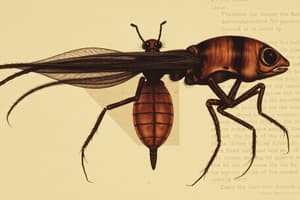Podcast
Questions and Answers
What is the geographical distribution of Diphyllobothrium latum?
What is the geographical distribution of Diphyllobothrium latum?
- African countries and foci in Europe
- Asian countries and foci in Australia
- South American countries and foci in Asia
- European Baltic countries and foci in America and Russia (correct)
What is the size range of adult Diphyllobothrium latum?
What is the size range of adult Diphyllobothrium latum?
- 3-10 meters in length (correct)
- 20-30 centimeters in length
- 1-2 centimeters in length
- 50-60 meters in length
What is the intermediate host for Diphyllobothrium latum?
What is the intermediate host for Diphyllobothrium latum?
- First intermediate host: Snails. Second intermediate host: Pigs.
- First intermediate host: Cattle. Second intermediate host: Sheep.
- First intermediate host: Mosquitoes. Second intermediate host: Birds.
- First intermediate host: Cyclops (water flea). Second intermediate host: Fresh water fish. (correct)
What is the mode of infection for Diphyllobothrium latum?
What is the mode of infection for Diphyllobothrium latum?
What is the morphology of Diphyllobothrium latum's egg?
What is the morphology of Diphyllobothrium latum's egg?
What is the size range of adult Diphyllobothrium latum?
What is the size range of adult Diphyllobothrium latum?
Which host acts as the first intermediate host for Diphyllobothrium latum?
Which host acts as the first intermediate host for Diphyllobothrium latum?
What is the infective stage of Diphyllobothrium latum?
What is the infective stage of Diphyllobothrium latum?
Where is the habitat of Diphyllobothrium latum?
Where is the habitat of Diphyllobothrium latum?
What is the geographical distribution of Diphyllobothrium latum?
What is the geographical distribution of Diphyllobothrium latum?
Flashcards
Diphyllobothrium latum
Diphyllobothrium latum
A type of tapeworm that can reach up to 10 meters in length, typically found in the ileum and jejunum of infected individuals.
Cyclops
Cyclops
A type of small crustacean that acts as the first intermediate host for Diphyllobothrium latum.
Plerocercoid larva
Plerocercoid larva
The infective stage of Diphyllobothrium latum.
Adult Diphyllobothrium latum
Adult Diphyllobothrium latum
Signup and view all the flashcards
Second intermediate host
Second intermediate host
Signup and view all the flashcards
Size of Diphyllobothrium latum
Size of Diphyllobothrium latum
Signup and view all the flashcards
Mode of infection
Mode of infection
Signup and view all the flashcards
Morphology of Diphyllobothrium latum's egg
Morphology of Diphyllobothrium latum's egg
Signup and view all the flashcards
Geographical distribution
Geographical distribution
Signup and view all the flashcards
Habitat of Diphyllobothrium latum
Habitat of Diphyllobothrium latum
Signup and view all the flashcards
Study Notes
Geographical Distribution
- Diphyllobothrium latum is found in the Northern Hemisphere, particularly in the lakes and rivers of Europe, Asia, and North America.
Size Range
- Adult Diphyllobothrium latum can range from 5 to 10 meters in length.
Intermediate Hosts
- The first intermediate host of Diphyllobothrium latum is the copepod crustacean.
- The second intermediate host is a fish, such as pike, trout, or perch.
Mode of Infection
- Humans are infected with Diphyllobothrium latum through the consumption of raw or undercooked fish containing the parasite.
Egg Morphology
- The eggs of Diphyllobothrium latum are oval-shaped, operculated, and approximately 60-70 μm in length.
Habitat
- Diphyllobothrium latum is found in freshwater lakes and rivers.
Infective Stage
- The infective stage of Diphyllobothrium latum is the plerocercoid stage, which is found in fish.
Studying That Suits You
Use AI to generate personalized quizzes and flashcards to suit your learning preferences.




